Archive:European Neighbourhood Policy - East - statistics on trade in goods with the EU
This article focuses on the international trade in the European Neighbourhood Policy - East (ENP-E) countries, i.e. Armenia (AM), Azerbaijan (AZ), Belarus (BY), Georgia (GE), Moldova (MD) and Ukraine (UA). It provides detailed information on the main indicators of international trade (total exports/imports), the relationship of the ENP-East countries with the EU as an economical partner and the main types of goods exchanged.
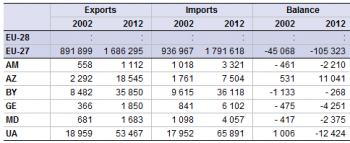
Source: for the EU-27, Eurostat (online data code: (ext_lt_intratrd)); for the ENP-East countries, Eurostat (online data code: (enpr_etmain)).
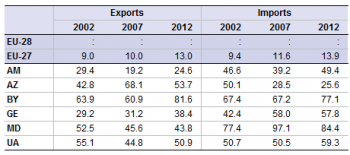
Source: for the EU-27, Eurostat (online data codes: (ext_lt_intratrd) and (nama_gdp_c)); for the ENP-East countries, Eurostat (online data code: (enpr_ecnagdp)).

Source: Eurostat (online data code: (enpr_etflow)).

Source: Eurostat (online data code: (enpr_etflow)).
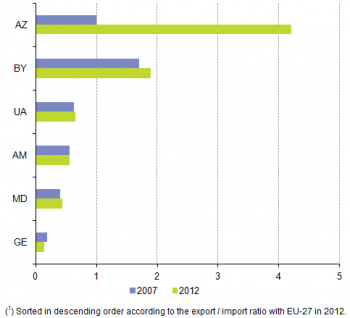
Source: Eurostat (online data code: (enpr_etflow)).
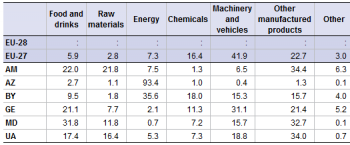
Source: for the EU-27, Eurostat (online data code: (ext_lt_intratrd)); for the ENP-East countries, Eurostat (online data code: (enpr_etsitc)).
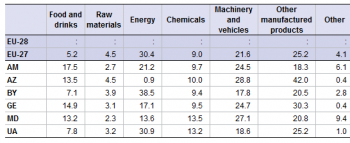
Source: for the EU-27, Eurostat (online data code: (ext_lt_intratrd)); for the ENP-East countries, Eurostat (online data code: (enpr_etsitc)).
Main statistical findings
Azerbaijan: the unique ENP-East country with a positive trade balance.
Over the period between 2001 and 2011, all ENP-East countries observed a significant growth in both their total amounts of exports and imports (see Table 1). The most noticeable figure concerns Azerbaijan where the total amount of exports rose up by more than seven-fold during the decade. This huge increase, which indeed started in 2008, is mainly explained by the oil trade resulting from the opening of the Baku-Tbilisi-Ceyhan pipeline connecting the Caspian Sea to the Mediterranean Sea.
In all other ENP-East countries, the amount of imports increased faster than that of exports during the same period.
For the same reason as explained above, Azerbaijan recorded an impressive 12-billion euro positive trade balance in 2011, making this country a unique case among the ENP-East countries. Indeed, the other five countries conceded trade deficits in 2011, ranging from 2 billion in Armenia to 10.2 billion in Ukraine. However, the situation had not always been similar since the latter also had a slight positive trade balance (0.5 billion euro) ten years before.
When comparing the amounts of exports and imports with the Gross Domestic Product (GDP), figures are relatively different between all ENP-East countries (see Table 2). Nevertheless, one characteristic is common to all of them: their share of both exports and imports expressed in percentage of the GDP have been much higher than the EU average all along the period between 2001 and 2011.
The highest figures and increases over the last years concern Belarus, where both the share of exports and of imports relative to the GDP bordered on 90%. As stated by the Ministry of Foreign Affairs of Belarus, this might be partially explained by significant changes in the monetary and fiscal policy of trade of goods. (http://www.mfa.gov.by/en/foreign_trade/results/a9dc20b94a9ee762.html )
The EU as a main trading partner of the ENP-East countries
The EU is a key partner of the ENP-East countries in terms of trade of goods and service (see Figure 1). Indeed, the EU was by far the favourite counterpart for exports in Azerbaijan in 2011 (60% of its total exports) and to lesser extent for Moldova (49%), Armenia (46%) and Belarus (39%). As regards the share of imports from the EU, Moldova took the lead in 2011 among ENP-East countries (43% of its total imports), whilst Azerbaijan and Ukraine ranked second and third (32% and 31% respectively) shortly before Georgia (28%) and Armenia (26%).
When looking deeper at the trade in goods in value between the EU and ENP-East countries, Ukraine was still by far the highest importer of goods and services from the EU in 2011 (18.5 billion euro), in line with the tendency since 2001 (see table 3).
However, its traditional leadership in values of exports (12.9 billion euro in 2011) is now being seriously challenged by Azerbaijan and Belarus (11.3 billion euro each). The latter are by the way the only two ENP-East countries recording a positive trade balance with the EU in 2011 (9.1 and 5.1 billion euro respectively) far above the steadily increasing trade deficits of Ukraine with the EU (over 5.5 billion euro in 2011).
When turning the trade values into an export/import ratio, the data are striking: the values exports of Azerbaijan to the EU were five times higher than those of imports from the EU in 2011, a significant increasing ratio compared to 2006. In Belarus, the situation has not much changed during the same five-year period, since the values of exports to the EU remained nearly the double of those of their imports.
Different offers and different needs among ENP-East countries
The ENP-East countries relatively differed in the make-up of the goods they exchange with the world (see Table 4), This is the case for the goods they export: whereas Azerbaijan and Belarus profit from their mineral resources to export energy products (94.7% and 35.5% of their total exports in 2011 respectively), the other four countries concentrated mainly their exports on machinery and vehicles (between 24.6% and 39.9% during the same reference year). The situation of the latter set of countries is closer to the general picture at European level where 41.7% of the EU exports concerned the machinery and vehicle industry.
Concerning the imports by types of goods (see table 5) the ENP-East countries can fairly be divided into three groups: the first group is made of the high energy importing countries and includes Belarus (41% of total imports in 2011) and Ukraine (34.6%). The other main products these countries did import concerned machinery, vehicles and other manufactured products. Actually this group appears to have the same trade profile as the EU, where imports of energy products also stripped out the other two abovementioned categories.
The second group depended also on the same three types of goods but with lower imports of energy and higher ones on machinery and manufactured products. It concerns Armenia, Georgia (2010 data) and Moldova where the aggregated share of the three types of commodities accounted for about two thirds of the total imports of each countries. Also non negligible for this group of countries was the share of imported food and drink products (between 12.4% and 17.4%).
The last distinguishable group is indeed made of Azerbaijan only, since this country is absolutely energy independent. Therefore, about half of the products Azerbaijan imported in 2011 concerned ‘other manufactured products’ (48.6%). When adding them up to the 24.9% of machinery and vehicles, and to the 13.2% of food and drink products, the share of these three categories of products reached more than 86% of the total Azerbaijani imports in 2011.
Data sources and availability
The data for the ENP-East countries are supplied by and under the responsibility of the national statistical authorities of each of the countries or territories on a voluntary basis. Data from other sources are very limited and clearly identified. The data for Armenia, Azerbaijan, Belarus, Georgia, Moldova and Ukraine are taken from the key indicators that are collected on a regular basis by Eurostat. The statistics that are included in this article are freely available on-line.
Context
Trade statistics are of prime importance for both public (decision makers at an international, EU and national level) and private users, as they provide valuable information on the current trends in the exchange of goods within a specific geographical area. Moreover, they enable the EU to monitor the progress in strengthening trade ties with ENP partners as it is recognised that “trade in goods and services is a powerful instrument to stimulate economic growth, enhance competitiveness and support economic recovery” [1].
Moreover, they enable the EU to prepare multilateral and bilateral negotiations on a common trade policy. Furthermore, international trade statistics support European businesses in their market surveys and improve their competitiveness.
The policy context of the European Neighbourhood Policy (ENP) is explained here.
Further Eurostat information
Database
See: International Trade (enpr_et)
- ENP countries: international trade - main indicators (enpr_etmain)
- ENP countries: Trading partners - flows (enpr_etflow)
- ENP countries: Trade by commodity (SITC) (enpr_etsitc)
See: International Trade long-term indicators (ext_lti)
- International trade (ext_lti_int)
+ International trade of EU, the euro area and the Member States by SITC product group (ext_lt_intertrd)
- EU trade by Member State, by partner and by product group (ext_lti_ext)
+ Intra and Extra-EU trade by Member State and by product group (ext_lt_intratrd)
- [(http://epp.eurostat.ec.europa.eu/portal/page/portal/national_accounts/data/database Annual national accounts (nama)]
See: GDP and main components (nama_gdp)
- GDP and main components - Current prices (nama_gdp_c)
Main tables
- Title(s) of second level folder (if any)
- Title(s) of third level folder (if any)
Database
- Title(s) of second level folder (if any)
- Title(s) of third level folder (if any)
Dedicated section
Methodology / Metadata
<link to ESMS file, methodological publications, survey manuals, etc.>
- Name of the destination ESMS metadata file (ESMS metadata file - ESMS code, e.g. bop_fats_esms)
- Title of the publication
Source data for tables, figures and maps (MS Excel)
Other information
<Regulations and other legal texts, communications from the Commission, administrative notes, Policy documents, …>
- Regulation 1737/2005 (generating url [http://eur-lex.europa.eu/LexUriServ/LexUriServ.do?uri=CELEX:32005R1737:EN:NOT Regulation 1737/2005]) of DD Month YYYY on ...
- Directive 2003/86/EC (generating url [http://eur-lex.europa.eu/LexUriServ/LexUriServ.do?uri=CELEX:32003L0086:EN:NOT Directive 2003/86/EC]) of DD Month YYYY on ...
- Commission Decision 2003/86/EC (generating url [http://eur-lex.europa.eu/LexUriServ/LexUriServ.do?uri=CELEX:32003D0086:EN:NOT Commission Decision 2003/86/EC]) of DD Month YYYY on ...
<For other documents such as Commission Proposals or Reports, see EUR-Lex search by natural number>
<For linking to database table, otherwise remove: {{{title}}} ({{{code}}})>
External links
See also
Notes
- ↑ Joint Communication by the High Representative of The Union For Foreign Affairs And Security Policy and the European Commission to the European parliament, the Council, the European economic and social committee and the Committee of the regions, “A new response to a changing Neighbourhood” 25/05/2011, COM(2011) 303, Brussels.